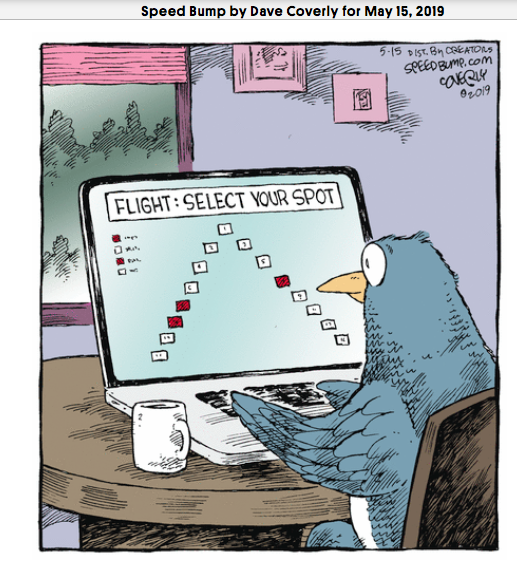We have all seen migrating birds traveling in a V-formation. It has long been speculated that this pattern is chosen because it reduces the energy required for flight in the birds that are at the back. But so much fine-tuning of positions was required to save energy by this method that some researchers doubted that this could be the reason and suggested alternatives, such as that the better navigators were in the front for others to follow or that this formation reduced the risk from predators.
But scientists were able to attach devices to a flock of birds and noticed that the birds were not just locating themselves precisely with respect to the lead birds as predicted by the aerodynamics of fixed wing aircraft, but that they were even synchronizing the flapping of their wings to achieve maximum energy savings.
To take maximum advantage of the V’s aerodynamics, each bird would have to position its wing in the upward-moving part of the vortex of air swirling off the end of the wingtip of the bird in front. But that vortex moves up and down because the bird in front is flapping. So the bird behind must not only put itself in the right place, but must also flap at just the right time — which changes depending on the distance between the birds — to keep riding the upwash.
…Portugal collected data for three flight days of the 36-day paraplane-led migration. From that, he selected a problem-free seven-minute segment to analyse. To his surprise, the analysis showed that the birds’ formation fitted the theoretical predictions of aerodynamics. “They’re placing themselves in the best place and flapping at the best time,” he says.
…Whatever their reasons, the birds clearly have a better ability to sense and respond to airflow than researchers gave them credit for. “In general, we know much less about the sensory system than the motor system in animal flight,” says biologist Bret Tobalske of the University of Montana in Missoula. One possibility, suggests Portugal, is that they use special feathers.
“They are just so aware of where each other are and what the other bird is doing,” Portugal says. “And that’s what I find really impressive.”
Here is a video where the researchers discuss their findings.
Birds are amazing.


It’s cool to see that birds will do what seems to be quite complex to be aerodynamically efficient but at the same time it seems quite obvious that they would and I’m surprised that there would be a debate among researchers on that. They also obviously don’t need to understand or even realise that they’re doing so because they are just doing what feels right to them.
If you’ve ever been on a motorcycle (it’s much more obvious on a motorcycle than in a car) on the highway behind a semi truck you don’t need to know anything about aerodynamics to know that at a certain distance you will get a lot of buffeting and if you get too close, you actually get sucked in the wake of the truck. So you learn where you should go.
The same goes with sports and other complex physical activities (e.g. dance, circus, …) where you don’t need to understand the physics to know when you’re doing something more efficiently. Of course, we have the advantage of being able to use physics and biomechanics to improve things but we’re also doing quite ‘unnatural’ activities. Bird ‘simply’ do what’s natural to them and it would seem to me that they would obviously fly in an efficient aerodynamic way.
I understand the desire to question why they would do what they do and it’s cool for us to be able to explain and confirm why but I don’t see why it should be surprising to researchers. Or maybe there never really was a serious debate and that is just put there to make it more interesting.
They must also be making adjustments depending on the prevailing winds and eddies in the air currents. I seem to live at the edge of the flyway for migrating snow geese who usually come cruising through around 10pm -- 2am. Despite thousands of them wintering in local wetlands, I guess I get the stragglers, with groups of maybe 6 to 20 honking their way through at a time. They only rarely fly over in the daytime.
They don’t seem all that adept at forming Vs though, often flying nearly abreast, with only the slightest V shape. The more in the group, the more haphazard the arrangement seems to be. And boy howdy do they love to talk to each other about it the whole way! I have to wonder if part of their formation structure has to do with acoustics, i.e., they’re not just mysteriously sensing the air currents, but they hear where everyone is and have learned to adjust their own position accordingly.
But I love hearing them coming through at night, and going out to see them passing over like noisy ghosts against the cold black sky.
Jean,
I think the real surprise was in the wing flap synchronization, which had not been noted before. The formation itself had been postulated a long time ago and this just confirmed it.
Mano,
But again, that’s cool and interesting that we do understand that but should not be surprising that they are doing what is most efficient. I’m sure they can feel it without even seeing the other birds in a similar way to which birds can spend hours in the air without flapping their wings simply by finding the smallest thermal.
By the way, I’m not trying to diminish the findings and saying that this is not fascinating. I’m just surprised at the claimed researchers surprise.
Jim Usherwood doing that flapping thing with both his hands is really impressive….